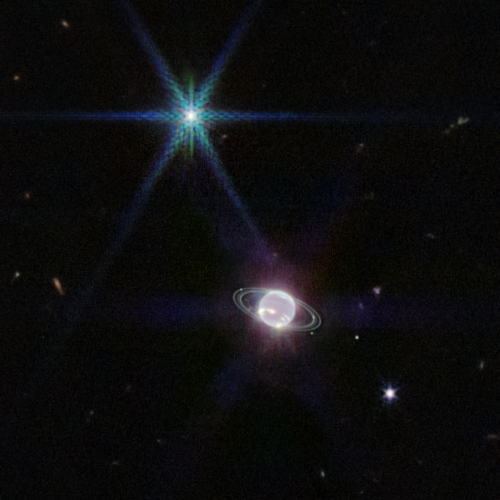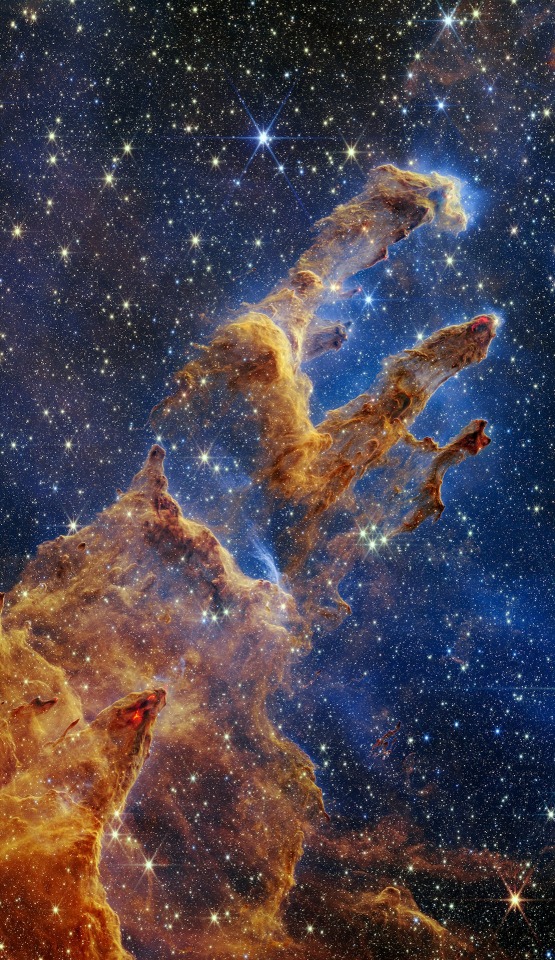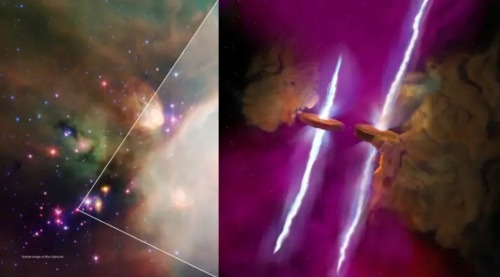Jwst - Tumblr Posts


With giant storms, powerful winds, auroras, and extreme temperature and pressure conditions, Jupiter has a lot going on. Now, NASA’s James Webb Space Telescope has captured new images of the planet. Webb’s Jupiter observations will give scientists even more clues to Jupiter’s inner life.
Credit: NASA, ESA, CSA, Jupiter ERS Team; image processing by Judy Schmidt. Read more
See the Universe in a New Way with the Webb Space Telescope's First Images
Are you ready to see unprecedented, detailed views of the universe from the James Webb Space Telescope, the largest and most powerful space observatory ever made? Scroll down to see the first full-color images and data from Webb. Unfold the universe with us. ✨
Carina Nebula

This landscape of “mountains” and “valleys” speckled with glittering stars, called the Cosmic Cliffs, is the edge of the star-birthing Carina Nebula. Usually, the early phases of star formation are difficult to capture, but Webb can peer through cosmic dust—thanks to its extreme sensitivity, spatial resolution, and imaging capability. Protostellar jets clearly shoot out from some of these young stars in this new image.
Southern Ring Nebula

The Southern Ring Nebula is a planetary nebula: it’s an expanding cloud of gas and dust surrounding a dying star. In this new image, the nebula’s second, dimmer star is brought into full view, as well as the gas and dust it’s throwing out around it. (The brighter star is in its own stage of stellar evolution and will probably eject its own planetary nebula in the future.) These kinds of details will help us better understand how stars evolve and transform their environments. Finally, you might notice points of light in the background. Those aren’t stars—they’re distant galaxies.
Stephan’s Quintet

Stephan’s Quintet, a visual grouping of five galaxies near each other, was discovered in 1877 and is best known for being prominently featured in the holiday classic, “It’s a Wonderful Life.” This new image brings the galaxy group from the silver screen to your screen in an enormous mosaic that is Webb’s largest image to date. The mosaic covers about one-fifth of the Moon’s diameter; it contains over 150 million pixels and is constructed from almost 1,000 separate image files. Never-before-seen details are on display: sparkling clusters of millions of young stars, fresh star births, sweeping tails of gas, dust and stars, and huge shock waves paint a dramatic picture of galactic interactions.
WASP-96 b

WASP-96 b is a giant, mostly gas planet outside our solar system, discovered in 2014. Webb’s Near-Infrared Imager and Slitless Spectrograph (NIRISS) measured light from the WASP-96 system as the planet moved across the star. The light curve confirmed previous observations, but the transmission spectrum revealed new properties of the planet: an unambiguous signature of water, indications of haze, and evidence of clouds in the atmosphere. This discovery marks a giant leap forward in the quest to find potentially habitable planets beyond Earth.
Webb's First Deep Field

This image of galaxy cluster SMACS 0723, known as Webb’s First Deep Field, looks 4.6 billion years into the past. Looking at infrared wavelengths beyond Hubble’s deepest fields, Webb’s sharp near-infrared view reveals thousands of galaxies—including the faintest objects ever observed in the infrared—in the most detailed view of the early universe to date. We can now see tiny, faint structures we’ve never seen before, like star clusters and diffuse features and soon, we’ll begin to learn more about the galaxies’ masses, ages, histories, and compositions.
These images and data are just the beginning of what the observatory will find. It will study every phase in the history of our Universe, ranging from the first luminous glows after the Big Bang, to the formation of solar systems capable of supporting life on planets like Earth, to the evolution of our own Solar System.
Make sure to follow us on Tumblr for your regular dose of space—and for milestones like this!
Credits: NASA, ESA, CSA, and STScI
SHUT UP AND LOOK:

Neptune taken by JWST ♡
See the Universe in a New Way with the Webb Space Telescope's First Images
Are you ready to see unprecedented, detailed views of the universe from the James Webb Space Telescope, the largest and most powerful space observatory ever made? Scroll down to see the first full-color images and data from Webb. Unfold the universe with us. ✨
Carina Nebula

This landscape of “mountains” and “valleys” speckled with glittering stars, called the Cosmic Cliffs, is the edge of the star-birthing Carina Nebula. Usually, the early phases of star formation are difficult to capture, but Webb can peer through cosmic dust—thanks to its extreme sensitivity, spatial resolution, and imaging capability. Protostellar jets clearly shoot out from some of these young stars in this new image.
Southern Ring Nebula

The Southern Ring Nebula is a planetary nebula: it’s an expanding cloud of gas and dust surrounding a dying star. In this new image, the nebula’s second, dimmer star is brought into full view, as well as the gas and dust it’s throwing out around it. (The brighter star is in its own stage of stellar evolution and will probably eject its own planetary nebula in the future.) These kinds of details will help us better understand how stars evolve and transform their environments. Finally, you might notice points of light in the background. Those aren’t stars—they’re distant galaxies.
Stephan’s Quintet

Stephan’s Quintet, a visual grouping of five galaxies near each other, was discovered in 1877 and is best known for being prominently featured in the holiday classic, “It’s a Wonderful Life.” This new image brings the galaxy group from the silver screen to your screen in an enormous mosaic that is Webb’s largest image to date. The mosaic covers about one-fifth of the Moon’s diameter; it contains over 150 million pixels and is constructed from almost 1,000 separate image files. Never-before-seen details are on display: sparkling clusters of millions of young stars, fresh star births, sweeping tails of gas, dust and stars, and huge shock waves paint a dramatic picture of galactic interactions.
WASP-96 b

WASP-96 b is a giant, mostly gas planet outside our solar system, discovered in 2014. Webb’s Near-Infrared Imager and Slitless Spectrograph (NIRISS) measured light from the WASP-96 system as the planet moved across the star. The light curve confirmed previous observations, but the transmission spectrum revealed new properties of the planet: an unambiguous signature of water, indications of haze, and evidence of clouds in the atmosphere. This discovery marks a giant leap forward in the quest to find potentially habitable planets beyond Earth.
Webb's First Deep Field

This image of galaxy cluster SMACS 0723, known as Webb’s First Deep Field, looks 4.6 billion years into the past. Looking at infrared wavelengths beyond Hubble’s deepest fields, Webb’s sharp near-infrared view reveals thousands of galaxies—including the faintest objects ever observed in the infrared—in the most detailed view of the early universe to date. We can now see tiny, faint structures we’ve never seen before, like star clusters and diffuse features and soon, we’ll begin to learn more about the galaxies’ masses, ages, histories, and compositions.
These images and data are just the beginning of what the observatory will find. It will study every phase in the history of our Universe, ranging from the first luminous glows after the Big Bang, to the formation of solar systems capable of supporting life on planets like Earth, to the evolution of our own Solar System.
Make sure to follow us on Tumblr for your regular dose of space—and for milestones like this!
Credits: NASA, ESA, CSA, and STScI

Black Hole! featuring beautiful images from JWST in the background :)
Let's go visit it. Who's with me?

JWST Looks Towards the Most Distant Star Ever Seen
JWST was designed to look towards the early universe, and there we see countless galaxies, but individual stars are usually far too faint to really be able to separate from all the other stars around them. Even galaxies fairly close to us can be a huge technical challenge to zoom in to the point of being able to see individual stars, and when you consider the closest star (not counting our sun) isn't even visible in the night sky to the naked eye at 4.24 light years, when we're talking millions even billions of light years, just seeing the galaxies is a miracle within itself.
That was until Hubble picked out Earendel, an actual individual star gravitationally lensed across 12.9 billion light years.

What was exciting about this was that this star was in existence within the first billion years of the universe, so maybe it was a population III star, one of the original stars theorised to have populated that early universe. The problem for Hubble was, being an optical telescope, it couldn't see all of the wavelength data coming from the star, only that which had become visible after being red shifted.
Now, JWST has also done the same, and it has the data to see what kind of star this is, and interestingly it's a blue B type star, much more massive than our Sun, but similar to the kind of stars most visible in open clusters, and born today in our own galaxy.
What's more, JWST also detected red light, potentially pointing at a companion star, which wouldn't be too surprising given most B type stars are binary in nature.

While this star doesn't appear to be a Population III star, it is evidence that we can pick out light from some of the earliest stars in our universe, and expectations are that it's only a matter of time before such a star is detected.
Source:

ohhhh my god webb got an image of the pillars of creation and it’s absolutely STUNNING.

here it is compared to hubbles image:



Rho Ophiuchi cloud cluster
~Happy anniversary to the James Webb Space Telescope~


Peering Into the Tendrils of NGC 604 l Webb

Cosmic Cliffs in Carina © JWST
Daily space post lasted for 2 days bc I'm busy, so get ready for...
✨️sometimes regular space posts✨️
Nasa recently used two different telescopes to discover that what was previously believed to be one star in the WL20 star system is actually two twin stars. They discovered this because they found two distinguished disc with parallel jets of light erupting from around the stars.










